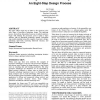PERSUASIVE
2009
Springer
14 years 9 months ago
2009
Springer
This paper outlines eight steps to follow as best practices in the early stages of persuasive technology design. The eight-step process, drawn from demonstrated successes in indus...
PERSUASIVE
2009
Springer
14 years 9 months ago
2009
Springer
We present an empirical study of the effect of a computer agent designed to engage a user in a persuasive counseling dialogue on attitudes towards regular exercise. We used two ma...
PERSUASIVE
2009
Springer
14 years 9 months ago
2009
Springer
This paper discusses problems faced by planners of real-world online behavioural change interventions who must select behavioural change frameworks from a variety of competing the...
PERSUASIVE
2009
Springer
14 years 9 months ago
2009
Springer
Persuasive Technology has the potential to influence user behavior for social benefit, e.g. to reduce environmental impact, but designers are lacking guidance choosing among desig...
PERSUASIVE
2009
Springer
14 years 9 months ago
2009
Springer
PERSUASIVE
2009
Springer
14 years 9 months ago
2009
Springer
Value Sensitive Design and Participatory Design are two methodological frameworks that account for ethical issues throughout the process of technology design. Through analysis and...
PERSUASIVE
2009
Springer
14 years 9 months ago
2009
Springer
PERSUASIVE
2009
Springer
14 years 9 months ago
2009
Springer
This paper presents a new way of categorizing behavior change in a framework called the Behavior Grid. This preliminary work shows 35 types of behavior along two categorical dimen...
PERSUASIVE
2009
Springer
14 years 9 months ago
2009
Springer
Experiencing emotional distress is the number one reason why people who are undergoing behaviour modification (e.g. quitting smoking, dieting) suffer from relapses. Providing emot...
PERSUASIVE
2009
Springer
14 years 9 months ago
2009
Springer
Engagement with computer games causes children and adolescent users to spend a substantial amount of time at sedentary game playing activity. We hypothesise that this engagement c...






